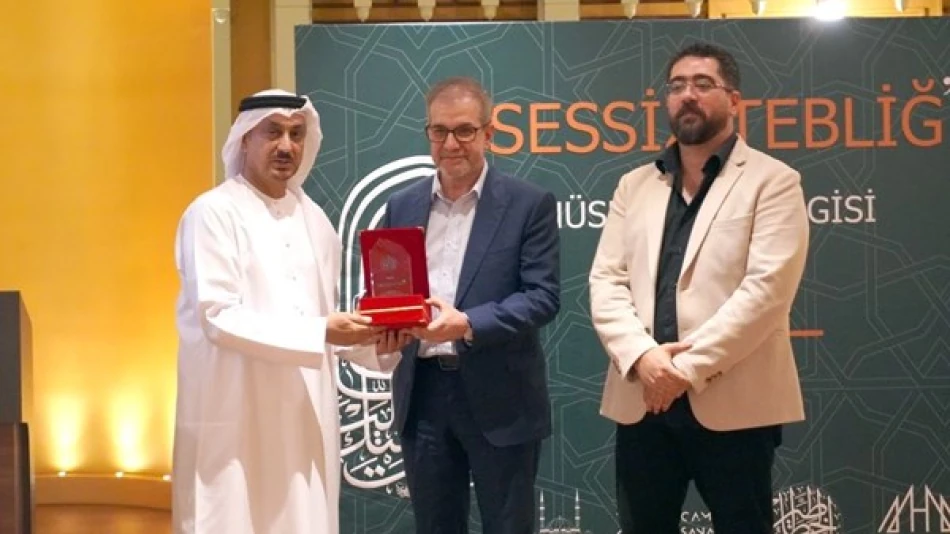
Sharjah's Prestigious Achievement: International Accolade Earned in Istanbul
UAE Designer's Calligraphy-Architecture Fusion Wins Global Recognition as Cultural Diplomacy Takes New Form
The "Diwani-Sharjah" project by Emirati designer Hisham Al Mazloum has secured its third international award in a single year, this time at Istanbul's First International Exhibition of Calligraphers School. The building represents the world's first architectural structure to seamlessly blend Arabic calligraphy with contemporary design, signaling a new era where cultural heritage meets modern innovation in the Gulf's architectural landscape.
Breaking Architectural Boundaries
Al Mazloum presented his groundbreaking work at an international artistic symposium hosted by Turkey's Gelişim University, where he detailed the creative process behind what he calls "letter architecture." The Diwani project stands as a testament to how traditional Islamic arts can be reimagined for the 21st century without losing their cultural essence.
The designer dedicated this latest recognition to Sheikh Dr. Sultan bin Mohammed Al Qasimi, Ruler of Sharjah, acknowledging the emirate's consistent support for artistic and cultural movements. This dedication underscores Sharjah's strategic positioning as a cultural hub that bridges traditional Islamic heritage with contemporary global trends.
A Year of International Acclaim
The project's rapid accumulation of prestigious awards demonstrates growing global interest in culturally-rooted contemporary architecture. Within twelve months, Diwani-Sharjah has claimed:
The Loop Design Awards for best contemporary architectural design, competing against international projects that typically favor Western architectural paradigms. The American Vision Architizer Award for best contemporary building photography, highlighting how the structure's visual impact transcends cultural boundaries. Best Architectural Residence 2024 from Sharjah's Planning and Survey Department, cementing its local significance.
Regional Recognition Follows Global Success
Beyond international acclaim, the project has gained recognition from key regional cultural institutions, including Cairo's International Forum for Arabic Calligraphy organized by Egypt's Ministry of Culture, and the International Conference on "Integration between Creativity, Technology and Innovation" at Mansoura University.
Cultural Diplomacy Through Design
The Istanbul exhibition, running from August 2-13 at the Taksim Mosque Culture and Arts Center, attracted over 50 calligraphers from 13 countries and displayed more than 150 artistic pieces. The event's diverse attendance—including representatives from the Organization of Islamic Cooperation, Kuwait's Islamic Center, and cultural figures from GCC states, Yemen, Syria, and Iraq—illustrates how architectural innovation can serve as a diplomatic tool.
This gathering reflects a broader trend where Gulf states leverage cultural projects to enhance soft power and regional influence. Similar to how the UAE's Louvre Abu Dhabi and Qatar's National Museum have elevated their nations' cultural profiles, the Diwani project positions Sharjah as a center for Islamic architectural innovation.
Market Implications for Cultural Architecture
The project's success signals growing market demand for culturally-authentic contemporary design, particularly in regions seeking to balance modernization with heritage preservation. For investors and developers, this trend suggests profitable opportunities in projects that integrate traditional Islamic arts with modern functionality.
The recognition also validates Sharjah's investment strategy in cultural infrastructure, potentially attracting international architects and designers to explore similar fusion concepts. This could establish the emirate as a testing ground for innovative Islamic architecture, similar to how Singapore became a hub for sustainable building design.
Redefining Islamic Architecture
Al Mazloum's concept of "letter architecture" challenges conventional approaches to Islamic design, which often treat calligraphy as decorative rather than structural. "The relationship between the letter and the building is reciprocal—the building is made of letters, and the letters are part of the building," he explained, describing a methodology that could influence future mosque, cultural center, and residential designs across the Islamic world.
This approach offers a compelling alternative to the glass-and-steel uniformity that has dominated Gulf architecture, providing a template for developments that maintain cultural identity while meeting contemporary needs. As regional governments increasingly emphasize cultural authenticity in their vision statements, projects like Diwani-Sharjah may become blueprints for future urban development strategies.
Most Viewed News

 Layla Al Mansoori
Layla Al Mansoori






